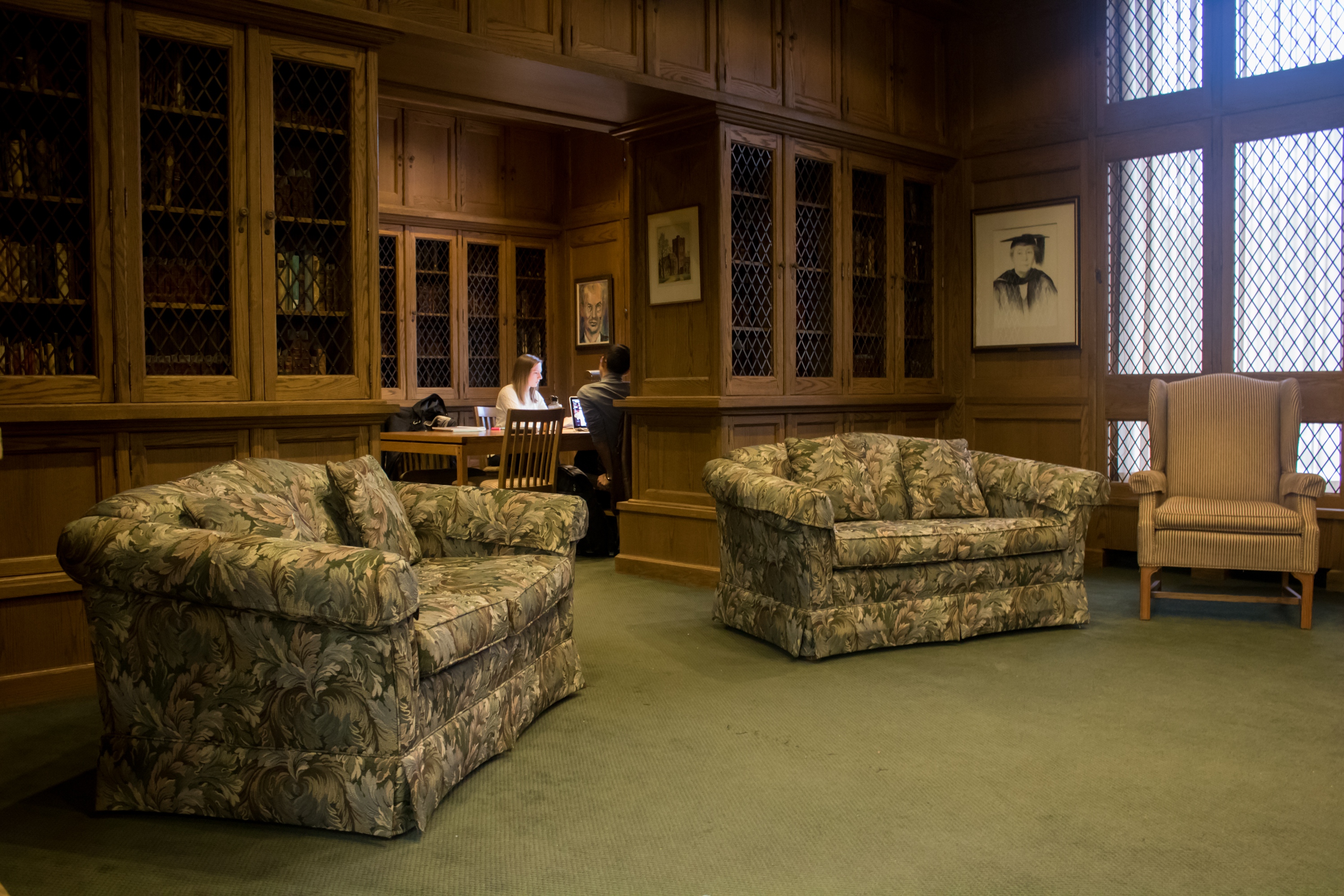The Milwaukee-Downer Room is located on the first floor of the Seeley G. Mudd Library.
Photo by Larissa Davis.
The Milwaukee-Downer Room is just as full of magic as one would expect from a space popularly referred to as the ‘Harry Potter room.’ Sheltered from the bright entrance floor of the library by heavy, wooden doors, the Milwaukee-Downer room surrounds students with shelves of mysterious, old books hidden behind protective grates. Unlike the restricted section of Hogwarts’ library, muggle students can easily obtain the books (and they won’t scream in a person’s face when opened). University Archivist and Assistant Professor Erin Dix as well as Director of Technical Services and Assistant Professor Jill Thomas shared expertise regarding the historic room.
“The room itself was known as the ‘Heritage Room’ when the Seeley G. Mudd Library opened in 1975,” Dix explained. The one-time Heritage Room was built to resemble the Oak Room, an original favorite on the Milwaukee-Downer campus. In tribute to the original women’s college, Dix said “The name was changed to the Milwaukee-Downer Room in 2001 to recognize Milwaukee-Downer’s 150th anniversary.”
Thomas was able to give a sense of the wealth of reading and research materials available for use in the Milwaukee-Downer room. Estimating that there are 35,000 titles in the room, Thomas was able to highlight some of the “hallmarks of what the collection has as far as the standout pieces.”
Thomas explained that the Milwaukee-Downer Room contains an edition of the index of forbidden books from 1618, written by the Catholic Church up to the middle of the twentieth century and a first edition of ‘The Red Badge of Courage.’
Along with these, Thomas proudly highlighted that the collection has a commentary on the New Testament from Erasmus. “It’s a pretty famous third edition that we have in a very beautiful vellum binding with latches on it,” Thomas said, adding that along with this biblical piece, the collection hosts a leaf from the Gutenberg Bible.
Several classes make use of the Milwaukee-Downer Room’s resources. A collection of around 75 artist books has provided the opportunity for students to take a course specifically on the subject of artist books.
Thomas feels that “artist books are really interesting, because usually they don’t come out more than 10 at a time. The [books] are very personal so that you really get a great sense of the artists themselves as you’re looking through their pieces.”
Another class, the ‘History of the Book,’ is able to directly use the Milwaukee Downer collection for firsthand resources. An art history class on manuscripts makes use of facsimiles of Vatican manuscripts. Thomas talked about a few special learning opportunities that took place in the Milwaukee-Downer Room in the past as well.
“Every now and then we can have special kinds of talks that have to do with the collection or something that is relevant to the collection,” Thomas explained. “We had a donor loan us, for a while, a manuscript copy of one of Mozart’s handwritten pieces and all the composition students from the conservatory came over and looked at it.”
Last year, a theater class made use of facsimiles of newspapers and posters from the Irish revolution, dating between 1917 and 1921 to 1922. “It’s always great to be able to share that information and have the students take a look at it,” Thomas remarked, thinking back on these extra exhibitions.
While there are already a number of ways in which the Milwaukee-Downer Room is utilized, Thomas strongly encourages students and faculty alike to make further use of the resources offered there.
Thomas listed some potential ways in which different departments could use the titles offered: “We have a lot of classical material that the classics could use. We have a Euclid math book that the math department could use…there are quite a few literary things you could read, there’s a lot of music, there’s some drama [and] librettos that we have that would be interesting to perform…it’s a very eclectic and general collection.”
Anyone can access the Milwaukee-Downer Room’s resources. Thomas explained, “When you request something, you go to the reference librarian’s desk, you request a piece with the call number, they make sure that you sign the registration so that we know who you are and we take your ID and go get the book…when you’re finished, bring the book back to the reference librarian.”
While the books in the Milwaukee-Downer Room cannot be checked out of the library like other books, readers may request that a book be stored in a specific closet for easy re-access. Thomas also encourages people interested in the collection to get in contact with her.
“I like to be able to at least talk to them about what is it that you’re looking at,” Thomas said, adding, “I could help them either narrow what they’re looking at, or give them more examples.” Whether searching for materials for an upcoming research project or to take a step into the past, be sure to check out what the Milwaukee-Downer Room has to offer.

